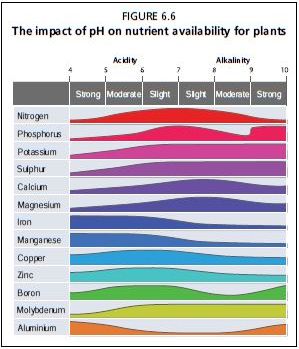6.3 WATER QUALITY FOR PLANTS
Section 3.3 discussed water quality parameters for the aquaponic system as a whole. Here specific considerations for plants are considered and further expanded.
6.3.1 PH
The pH is the most important parameter for plants in an aquaponic system because it influences a plant's access to nutrients. In general, the tolerance range for most plants is 5.5-7.5. The lower range is below the tolerance for fish and bacteria, and most plants prefer mildly acidic conditions. If the pH goes outside of this range, plants experience nutrient lockout, which means that although the nutrients are present in the water the plants are unable to use. them. This is especially true for iron, calcium and magnesium. Sometimes, apparent nutrient deficiencies in plants actually indicate that the pH of the system is outside the optimal range. Figure 6.6 describes the relationship between pH level and the ability for plants to take-up certain nutrients.
However, there is evidence that nutrient lockout is less common in mature aquaponic systems than in hydroponics. Whereas
FIGURE 6.6
The impact of pH on nutrient availability for plants

hydroponics is a semi-sterile undertaking, aquaponics is an entire ecosystem. As such, there are biological interactions occurring between the plant roots, bacteria and fungi that may allow nutrient uptake even at higher pH levels than those shown in Figure 6.6. However, the best course of action is to attempt to maintain pH slightly acidic (6-7), but understand that higher pH (7-8) may function. This aspect is the subject of current research.
6.3.2 Dissolved oxygen
Most plants need high levels of DO (> 3 mg/litre) within the water. Plants use their stems and leaves to absorb oxygen during respiration, but the roots also need to have oxygen. Without oxygen, the plants can experience root-rot, a situation where the roots die and fungus grows. Some water plants, such as water chestnut, lotus or taro, do not need high levels of DO and can withstand low-oxygen waters such as those in stagnant ponds.
6.3.3 Temperature and season
The suitable temperature range for most vegetables is 18-30 °C. However, some vegetables are far more suited to growing in particular conditions. For the purposes of this publication, winter vegetables require temperatures of 8-20 °C, and summer vegetables require temperatures of 17-30 °C. For example, many leafy green vegetables grow best in cooler conditions (14-20 °C), especially at night. In higher temperatures of 26 °C and above, leafy greens bolt and begin to flower and seed, which makes them bitter and unmarketable. Generally, it is the water temperature that has the greatest effect on the plants rather than the air temperature. Nevertheless, care should be taken in the correct choice of plants and fish to meet their optimal water temperature ranges. Another aspect of seasonal planting is that some plants require a certain amount of daylight to produce flowers and fruit, which is called photoperiodism. Some, referred to as short-day plants, require a certain amount of darkness before flowering. This signal to the plant indicates that winter is approaching, and the plant puts its energy into reproduction instead of growth. Some commonly grown, short-day plants include varieties of peppers and certain medicinal flowers. On the other hand, long- day plants require a certain day length before producing flowers, although this is rarely a consideration in vegetables but may be so for some ornamentals. As such, it is important to follow the local seasonal planting practices for each vegetable grown. or to choose varieties that are neutral to photoperiodism. Appendix 1 contains further details on individual vegetables.
6.3.4 Ammonia, nitrite and nitrate
As explained in Chapter 2, plants are able to take up all three forms of nitrogen, but nitrate is the most accessible. Ammonia and nitrite are very toxic to fish and should always be maintained below 1 mg/litre. In a functioning aquaponic unit, ammonia and nitrite are always 0-1 mg/litre and should not be a problem for the plants.